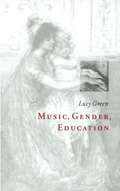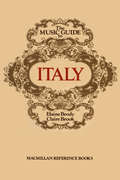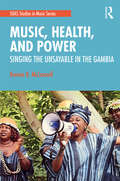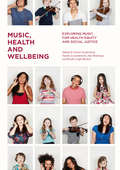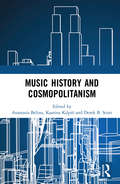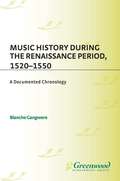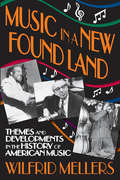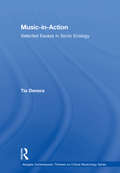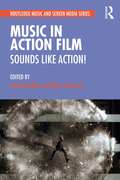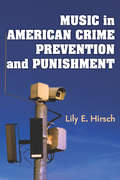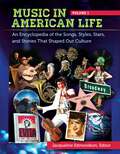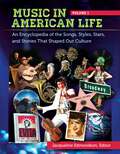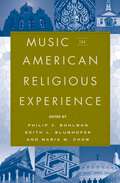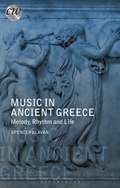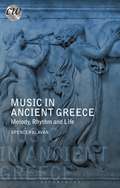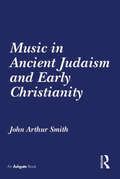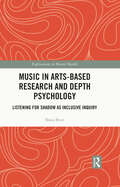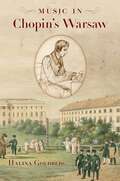- Table View
- List View
Music, Gender, Education (PDF)
by Lucy GreenThis book focuses on the role of education in relation to music and gender. Invoking a concept of musical patriarchy and a theory of the social construction musical meanings, Lucy Green shows how women's musical practices and gendered musical meanings have been reproduced, hand in hand, through history. Covering a wide range of music, including classical, jazz and popular styles, Dr Green uses ethnographic methods to convey the everyday interactions and experiences of girls, boys, and their teachers. She views the contemporary school music classroom as a microcosm of the wider society, and reveals the participation of music education in the continued production and reproduction of gendered musical practices and meanings.
Music, Health, and Power: Singing the Unsayable in The Gambia (SOAS Studies in Music Series)
by Bonnie B. McConnellMusic, Health, and Power offers an original, on-the-ground analysis of the role that music plays in promoting healthy communities. The book brings the reader inside the world of kanyeleng fertility societies and HIV/AIDS support groups, where women use music to leverage stigma and marginality into new forms of power. Drawing on ethnographic research conducted over a period of 13 years (2006–2019), the author articulates a strengths-based framework for research on music and health that pushes beyond deficit narratives to emphasize the creativity and resilience of Gambian performers in responding to health disparities. Examples from Ebola prevention programs, the former President’s AIDS “cure,” and a legendary underwear theft demonstrate the high stakes of women’s performances as they are caught up in broader contestations over political and medical authority. This book will be of interest to scholars and students of ethnomusicology, medical anthropology, and African studies. The accompanying audio examples provide access to the women’s performances discussed in the text.
Music, Health, and Power: Singing the Unsayable in The Gambia (SOAS Studies in Music Series)
by Bonnie B. McConnellMusic, Health, and Power offers an original, on-the-ground analysis of the role that music plays in promoting healthy communities. The book brings the reader inside the world of kanyeleng fertility societies and HIV/AIDS support groups, where women use music to leverage stigma and marginality into new forms of power. Drawing on ethnographic research conducted over a period of 13 years (2006–2019), the author articulates a strengths-based framework for research on music and health that pushes beyond deficit narratives to emphasize the creativity and resilience of Gambian performers in responding to health disparities. Examples from Ebola prevention programs, the former President’s AIDS “cure,” and a legendary underwear theft demonstrate the high stakes of women’s performances as they are caught up in broader contestations over political and medical authority. This book will be of interest to scholars and students of ethnomusicology, medical anthropology, and African studies. The accompanying audio examples provide access to the women’s performances discussed in the text.
Music, Health and Wellbeing: Exploring Music for Health Equity and Social Justice (PDF)
by Brydie-Leigh Bartleet Naomi Sunderland Natalie Lewandowski Dan BendrupsThis book explores the power music has to address health inequalities and the social determinants of health and wellbeing. It examines music participation as a determinant of wellbeing and as a transformative tool to impact on wider social, cultural and environmental conditions. Uniquely, in this volume health and wellbeing outcomes are conceptualised on a continuum, with potential effects identified in relation to individual participants, their communities but also society at large. While arts therapy approaches have a clear place in the text, the emphasis is on music making outside of clinical contexts and the broader roles musicians, music facilitators and educators can play in enhancing wellbeing in a range of settings beyond the therapy room. This innovative edited collection will be of great interest to scholars and practitioners of music, social services, medical humanities, education and the broader health field in the social and medical sciences.
Music History and Cosmopolitanism
by Anastasia Belina Kaarina Kilpiö Derek B. ScottThis collection of essays is the first book-length study of music history and cosmopolitanism, and is informed by arguments that culture and identity do not have to be viewed as primarily located in the context of nationalist narratives. Rather than trying to distinguish between a true cosmopolitanism and a false cosmopolitanism, the book presents studies that deepen understanding of the heritage of this concept – the various ways in which the term has been used to describe a wide range of activity and social outlooks. It ranges over a two hundred-year period, and more than a dozen countries, revealing how musicians and audiences have responded to a common humanity by embracing culture beyond regional or national boundaries. Among the various topics investigated are: musical cosmopolitanism among composers in Latin America, the Ottoman Empire, and Austro-Hungarian Empire; cosmopolitan popular music historiography; cosmopolitan musical entrepreneurs; and musical cosmopolitanism in the metropolises of New York and Shanghai.
Music History and Cosmopolitanism
by Anastasia Belina Kaarina Kilpiö Derek B. ScottThis collection of essays is the first book-length study of music history and cosmopolitanism, and is informed by arguments that culture and identity do not have to be viewed as primarily located in the context of nationalist narratives. Rather than trying to distinguish between a true cosmopolitanism and a false cosmopolitanism, the book presents studies that deepen understanding of the heritage of this concept – the various ways in which the term has been used to describe a wide range of activity and social outlooks. It ranges over a two hundred-year period, and more than a dozen countries, revealing how musicians and audiences have responded to a common humanity by embracing culture beyond regional or national boundaries. Among the various topics investigated are: musical cosmopolitanism among composers in Latin America, the Ottoman Empire, and Austro-Hungarian Empire; cosmopolitan popular music historiography; cosmopolitan musical entrepreneurs; and musical cosmopolitanism in the metropolises of New York and Shanghai.
Music History During the Renaissance Period, 1520-1550: A Documented Chronology (Music Reference Collection)
by Blanche M. GangwereThis annotated chronology of western music is the third in a series of outlines on the history of music in western civilization. It contains a 120-page annotated bibliography, followed by a detailed, documented outline that is divided into ten chapters. Each chapter is written in chronological order with every line being documented by means of abbreviations that refer to the annotated bibliography. There are short biographies of the theorists and detailed discussions of their works. The information on music is organized by classes of music rather than by composer. Also included are lists of manuscripts with descriptions of their contents and notations as to where they may be found. The material for the outline has been taken from primary and secondary sources along with articles from periodicals.Like the other two volumes in this series, Music History from the Late Roman through the Gothic Periods, 313-1425 and Music History During the Renaissance Period, 1425-1520, this volume will be an important research tool for anyone interested in music history.
Music in a New Found Land: Themes and Developments in the History of American Music
by Manfred HolthusThe subject of this book is accurately defined by its subtitle. Music in a New Found Land does not pretend to be a comprehensive history of American music. Nor does Mellers strive to catalog what he considers to be authentic American music. Instead, he deals, in some detail, with comparatively few composers, most of whom have wellestablished reputations.It has always been difficult to separate American music from its immediate relevance to the twentieth century. Mellers' theme involves the relationship between "art" music, jazz and pop music; he sees the segregation of these genres as both illogical and artifi cial. If the pop music of Tin Pan Alley may be anti-art, it has also produced Gershwin, Ellington, and composing improvisers such as Louis Armstrong, Charlie Parker, and Miles Davis.The study of American music is as relevant into any inquiry into a national culture as the study of American literature and painting. This book contains a large number of quotations from American writers, because Mellers thought American sensibility should parallel, reinforce, and comment on American music. In sum, this is the closest available one-volume history of American music, and a window into American culture.
Music in a New Found Land: Themes and Developments in the History of American Music
by Manfred HolthusThe subject of this book is accurately defined by its subtitle. Music in a New Found Land does not pretend to be a comprehensive history of American music. Nor does Mellers strive to catalog what he considers to be authentic American music. Instead, he deals, in some detail, with comparatively few composers, most of whom have wellestablished reputations.It has always been difficult to separate American music from its immediate relevance to the twentieth century. Mellers' theme involves the relationship between "art" music, jazz and pop music; he sees the segregation of these genres as both illogical and artifi cial. If the pop music of Tin Pan Alley may be anti-art, it has also produced Gershwin, Ellington, and composing improvisers such as Louis Armstrong, Charlie Parker, and Miles Davis.The study of American music is as relevant into any inquiry into a national culture as the study of American literature and painting. This book contains a large number of quotations from American writers, because Mellers thought American sensibility should parallel, reinforce, and comment on American music. In sum, this is the closest available one-volume history of American music, and a window into American culture.
Music-in-Action: Selected Essays in Sonic Ecology
by Tia DeNoraThis volume brings together DeNora‘s work published between 1986 and 2007. It includes thirteen essays, some of which have had a major impact on the field. The chapters trace the development of her work from its early concern with musical meaning, historical ethnography and theeveryday perspective, to its current focus on music in action. Topics covered include Adorno on Schoenberg and Stravinsky, a theory of music as a space and place for interpretive work, research methods for historical musicology, and the first key statement of her theory of music as an active ingredient in social life. These building blocks are then employed to investigate music and embodied experience, sexuality and gender differentiation, and music‘s role as a technology of health. The essays are set in a multi-disciplinary context with an autobiographical introduction.
Music-in-Action: Selected Essays in Sonic Ecology
by Tia DeNoraThis volume brings together DeNora‘s work published between 1986 and 2007. It includes thirteen essays, some of which have had a major impact on the field. The chapters trace the development of her work from its early concern with musical meaning, historical ethnography and theeveryday perspective, to its current focus on music in action. Topics covered include Adorno on Schoenberg and Stravinsky, a theory of music as a space and place for interpretive work, research methods for historical musicology, and the first key statement of her theory of music as an active ingredient in social life. These building blocks are then employed to investigate music and embodied experience, sexuality and gender differentiation, and music‘s role as a technology of health. The essays are set in a multi-disciplinary context with an autobiographical introduction.
Music in Action Film: Sounds Like Action!
by James Buhler Mark DurrandMusic in Action Film is the first volume to address the central role of music and sound in action film—arguably the most dominant form of commercial cinema today. Bringing together 15 essays by established and emerging scholars, the book encompasses both Hollywood blockbusters and international films, from classic works such as The Seven Samurai to contemporary superhero franchises. The contributors consider action both as genre and as a mode of cinematic expression, in chapters on evolving musical conventions; politics, representation, and identity; musical affect and agency; the functional role of music and sound design in action film; and production technologies. Breaking new critical ground yet highly accessible, this book will be of interest to students and scholars of music and film studies.
Music in Action Film: Sounds Like Action!
by James Buhler Mark DurrandMusic in Action Film is the first volume to address the central role of music and sound in action film—arguably the most dominant form of commercial cinema today. Bringing together 15 essays by established and emerging scholars, the book encompasses both Hollywood blockbusters and international films, from classic works such as The Seven Samurai to contemporary superhero franchises. The contributors consider action both as genre and as a mode of cinematic expression, in chapters on evolving musical conventions; politics, representation, and identity; musical affect and agency; the functional role of music and sound design in action film; and production technologies. Breaking new critical ground yet highly accessible, this book will be of interest to students and scholars of music and film studies.
Music in American Crime Prevention and Punishment
by Lily E HirschAlthough the use of music for extramusical purposes has been a part of American culture for some time, the phenomenon remained largely unknown to the general public until revelations became widespread of startling military practices during the second Iraq War. In Music in American Crime Prevention and Punishment, Lily E. Hirsch explores the related terrain at the intersection of music and law, demonstrating the ways in which music has become a tool of law enforcement and justice through: police and community leaders’ use of classical music in crime deterrence and punishment; the use of rap lyrics as prosecutorial evidence; allegations of music as incitement to violence; and the role of music in U.S. prisons and in detention centers in Guantanamo, Iraq, and Afghanistan. In the course of her study, Hirsch asks several questions: How does the law treat music? When and why does music participate in the law? How does music influence the legal process? How does the legal process influence music? And how do these appropriations affect the Romantic ideals underlying our view of music?
Music in American Life [4 volumes]: An Encyclopedia of the Songs, Styles, Stars, and Stories That Shaped Our Culture [4 volumes]
by Jacqueline EdmondsonA fascinating exploration of the relationship between American culture and music as defined by musicians, scholars, and critics from around the world.Music has been the cornerstone of popular culture in the United States since the beginning of our nation's history. From early immigrants sharing the sounds of their native lands to contemporary artists performing benefit concerts for social causes, our country's musical expressions reflect where we, as a people, have been, as well as our hope for the future. This four-volume encyclopedia examines music's influence on contemporary American life, tracing historical connections over time.Music in American Life: An Encyclopedia of the Songs, Styles, Stars, and Stories That Shaped Our Culture demonstrates the symbiotic relationship between this art form and our society. Entries include singers, composers, lyricists, songs, musical genres, places, instruments, technologies, music in films, music in political realms, and music shows on television.
Music in American Life [4 volumes]: An Encyclopedia of the Songs, Styles, Stars, and Stories That Shaped Our Culture [4 volumes]
A fascinating exploration of the relationship between American culture and music as defined by musicians, scholars, and critics from around the world.Music has been the cornerstone of popular culture in the United States since the beginning of our nation's history. From early immigrants sharing the sounds of their native lands to contemporary artists performing benefit concerts for social causes, our country's musical expressions reflect where we, as a people, have been, as well as our hope for the future. This four-volume encyclopedia examines music's influence on contemporary American life, tracing historical connections over time.Music in American Life: An Encyclopedia of the Songs, Styles, Stars, and Stories That Shaped Our Culture demonstrates the symbiotic relationship between this art form and our society. Entries include singers, composers, lyricists, songs, musical genres, places, instruments, technologies, music in films, music in political realms, and music shows on television.
Music in American Religious Experience
by Philip V. Bohlman Edith L. Blumhofer Maria M. ChowSince the appearance of The Bay Psalm Book in 1640, music has served as a defining factor for American religious experience and has been of fundamental importance in the development of American identity and psyche. The essays in this long-awaited volume explore the diverse ways in which music shapes the distinctive presence of religion in the United States and address the fullness of music's presence in American religious history. Timely, challenging, and stimulating, this collection will appeal to students and scholars of American history, American studies, religious studies, theology, musicology, and ethnomusicology, as well as to practicing sacred musicians.
Music in Ancient Greece: Melody, Rhythm and Life (Classical World)
by Spencer KlavanLife in ancient Greece was musical life. Soloists competed onstage for popular accolades, becoming centrepieces for cultural conversation and even leading Plato to recommend that certain forms of music be banned from his ideal society. And the music didn't stop when the audience left the theatre: melody and rhythm were woven into the whole fabric of daily existence for the Greeks. Vocal and instrumental songs were part of religious rituals, dramatic performances, dinner parties, and even military campaigns. Like Detroit in the 1960s or Vienna in the 18th century, Athens in the 400s BC was the hotspot where celebrated artists collaborated and diverse strands of musical tradition converged. The conversations and innovations that unfolded there would lay the groundwork for musical theory and practice in Greece and Rome for centuries to come. In this perfectly pitched introduction, Spencer Klavan explores Greek music's origins, forms, and place in society. In recent years, state-of-the-art research and digital technology have enabled us to decipher and understand Greek music with unprecedented precision. Yet many readers today cannot access the resources that would enable them to grapple with this richly rewarding subject. Arcane technical details and obscure jargon veil the subject - it is rarely known, for instance, that authentic melodies still survive from antiquity, helping us to imagine the vivid soundscapes of the Classical and Hellenistic eras. Music in Ancient Greece distills the latest discoveries into vivid prose so readers can come to grips with the basics as never before. With the tools in this book, beginners and specialists alike will learn to hear the ancient world afresh and come away with a new, musical perspective on their favourite classical texts.
Music in Ancient Greece: Melody, Rhythm and Life (Classical World)
by Spencer KlavanLife in ancient Greece was musical life. Soloists competed onstage for popular accolades, becoming centrepieces for cultural conversation and even leading Plato to recommend that certain forms of music be banned from his ideal society. And the music didn't stop when the audience left the theatre: melody and rhythm were woven into the whole fabric of daily existence for the Greeks. Vocal and instrumental songs were part of religious rituals, dramatic performances, dinner parties, and even military campaigns. Like Detroit in the 1960s or Vienna in the 18th century, Athens in the 400s BC was the hotspot where celebrated artists collaborated and diverse strands of musical tradition converged. The conversations and innovations that unfolded there would lay the groundwork for musical theory and practice in Greece and Rome for centuries to come. In this perfectly pitched introduction, Spencer Klavan explores Greek music's origins, forms, and place in society. In recent years, state-of-the-art research and digital technology have enabled us to decipher and understand Greek music with unprecedented precision. Yet many readers today cannot access the resources that would enable them to grapple with this richly rewarding subject. Arcane technical details and obscure jargon veil the subject - it is rarely known, for instance, that authentic melodies still survive from antiquity, helping us to imagine the vivid soundscapes of the Classical and Hellenistic eras. Music in Ancient Greece distills the latest discoveries into vivid prose so readers can come to grips with the basics as never before. With the tools in this book, beginners and specialists alike will learn to hear the ancient world afresh and come away with a new, musical perspective on their favourite classical texts.
Music in Ancient Judaism and Early Christianity
by John Arthur SmithIn Music in Ancient Judaism and Early Christianity, John Arthur Smith presents the first full-length study of music among the ancient Israelites, the ancient Jews and the early Christians in the Mediterranean lands during the period from 1000 BCE to 400 CE. He considers the physical, religious and social setting of the music, and how the music was performed. The extent to which early Christian music may have retained elements of the musical tradition of Judaism is also considered. After reviewing the subject's historical setting, and describing the main sources, the author discusses music at the Jerusalem Temple and in a variety of spheres of Jewish life away from it. His subsequent discussion of early Christian music covers music in private devotion, monasticism, the Eucharist, and gnostic literature. He concludes with an examination of the question of the relationship between Jewish and early Christian music, and a consideration of the musical environments that are likely to have influenced the formation of the earliest Christian chant. The scant remains of notated music from the period are discussed and placed in their respective contexts. The numerous sources that are the foundation of the book are evaluated objectively and critically in the light of modern scholarship. Due attention is given to where their limitations lie, and to what they cannot tell us as well as to what they can. The book serves as a reliable introduction as well as being an invaluable guide through one of the most complex periods of music history.
Music in Ancient Judaism and Early Christianity
by John Arthur SmithIn Music in Ancient Judaism and Early Christianity, John Arthur Smith presents the first full-length study of music among the ancient Israelites, the ancient Jews and the early Christians in the Mediterranean lands during the period from 1000 BCE to 400 CE. He considers the physical, religious and social setting of the music, and how the music was performed. The extent to which early Christian music may have retained elements of the musical tradition of Judaism is also considered. After reviewing the subject's historical setting, and describing the main sources, the author discusses music at the Jerusalem Temple and in a variety of spheres of Jewish life away from it. His subsequent discussion of early Christian music covers music in private devotion, monasticism, the Eucharist, and gnostic literature. He concludes with an examination of the question of the relationship between Jewish and early Christian music, and a consideration of the musical environments that are likely to have influenced the formation of the earliest Christian chant. The scant remains of notated music from the period are discussed and placed in their respective contexts. The numerous sources that are the foundation of the book are evaluated objectively and critically in the light of modern scholarship. Due attention is given to where their limitations lie, and to what they cannot tell us as well as to what they can. The book serves as a reliable introduction as well as being an invaluable guide through one of the most complex periods of music history.
Music in Arts-Based Research and Depth Psychology: Listening for Shadow as Inclusive Inquiry (ISSN)
by Shara BrunThis book addresses an existing gap in academic arts-based research, whereby, rather than exploring music as an effective therapeutic intervention, it is explored as the central medium or tool of inquiry.Integrating heuristic, hermeneutic, and arts-based grounded theory methodologies, the book conceptualizes and describes the practice of Sonic Stretching as an in-depth example of using sound as an effective and systematic research tool. Stemming from evidence-based insights, the book explores and explains ways in which music and sound can be utilized in arts-based research (ABR) in all disciplines, as opposed to only being used among professional musicians and those operating within music studies. It points to some of the obstacles that have previously prevented this from happening more broadly and, in doing so, aims to help bridge the conspicuous gap in ABR studies, where music and sonic imagination should be.Offering a clear and well-presented example for integrating music and sound into processes of depth psychological inquiry and addressing the impact of colonialization upon embodied knowledge in music and academic research, it will appeal to scholars and researchers working at the intersection of psychology, music studies, education, social justice, and research methods.
Music in Arts-Based Research and Depth Psychology: Listening for Shadow as Inclusive Inquiry (ISSN)
by Shara BrunThis book addresses an existing gap in academic arts-based research, whereby, rather than exploring music as an effective therapeutic intervention, it is explored as the central medium or tool of inquiry.Integrating heuristic, hermeneutic, and arts-based grounded theory methodologies, the book conceptualizes and describes the practice of Sonic Stretching as an in-depth example of using sound as an effective and systematic research tool. Stemming from evidence-based insights, the book explores and explains ways in which music and sound can be utilized in arts-based research (ABR) in all disciplines, as opposed to only being used among professional musicians and those operating within music studies. It points to some of the obstacles that have previously prevented this from happening more broadly and, in doing so, aims to help bridge the conspicuous gap in ABR studies, where music and sonic imagination should be.Offering a clear and well-presented example for integrating music and sound into processes of depth psychological inquiry and addressing the impact of colonialization upon embodied knowledge in music and academic research, it will appeal to scholars and researchers working at the intersection of psychology, music studies, education, social justice, and research methods.
Music in Chopin's Warsaw
by Halina GoldbergMusic in Chopin's Warsaw examines the rich musical environment of Fryderyk Chopin's youth--largely unknown to the English-speaking world--and places Chopin's early works in the context of this milieu. Halina Goldberg provides a historiographic perspective that allows a new and better understanding of Poland's cultural and musical circumstances. Chopin's Warsaw emerges as a vibrant European city that was home to an opera house, various smaller theaters, one of the earliest modern conservatories in Europe, several societies which organized concerts, musically active churches, spirited salon life, music publishers and bookstores, instrument builders, and for a short time even a weekly paper devoted to music. Warsaw was aware of and in tune with the most recent European styles and fashions in music, but it was also the cradle of a vernacular musical language that was initiated by the generation of Polish composers before Chopin and which found its full realization in his work. Significantly, this period of cultural revival in the Polish capital coincided with the duration of Chopin's stay there--from his infancy in 1810 to his final departure from his homeland in 1830. An uncanny convergence of political, economic, social, and cultural circumstances generated the dynamic musical, artistic, and intellectual environment that nurtured the developing genius. Had Chopin been born a decade earlier or a decade later, Goldberg argues, the capital--devastated by warfare and stripped of all cultural institutions--could not have provided support for his talent. The young composer would have been compelled to seek musical education abroad and thus would have been deprived of the specifically Polish experience so central to his musical style. A rigorously-researched and fascinating look at the Warsaw in which Chopin grew up, this book will appeal to students and scholars of nineteenth century music, as well as music lovers and performers.
